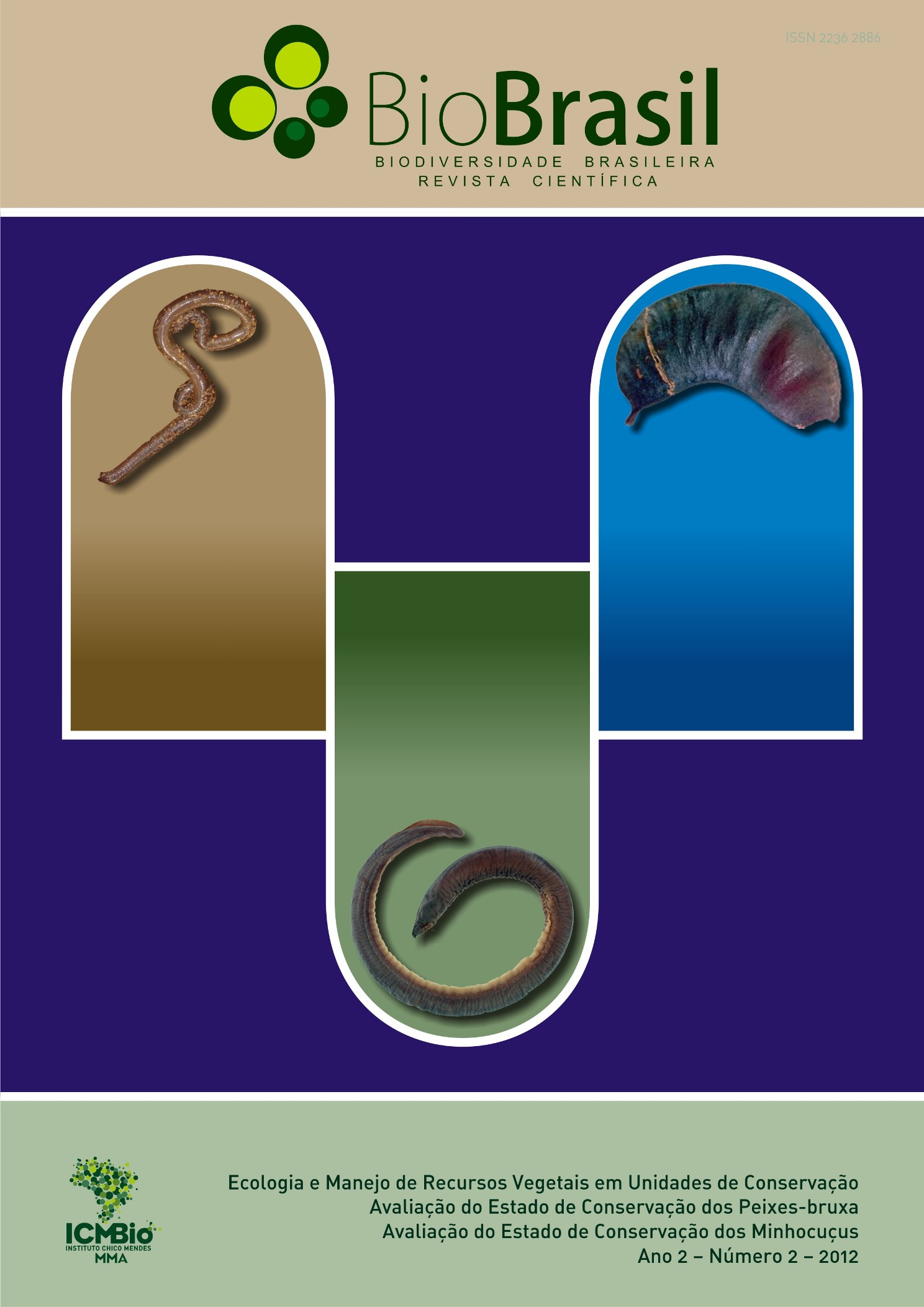Uso e práticas de manejo de faveira (Dimorphandra gardneriana Tul.) na região da Chapada do Araripe, Ceará: implicações ecológicas e sócio-econômicas
DOI:
https://doi.org/10.37002/biodiversidadebrasileira.v2i2.274Keywords:
Araripe National Forest, demography, medicinal plant, protected areaAbstract
The management and utilization of plant resources in the Araripe Plateau, state of Ceará,
comprises practices that have been recorded since the XIX century. Dimorphandra gardneriana Tul. (faveira)
has medicine properties and has been harvested because of pharmaceutical industry needs. This paper bring
a review of the studies about Dimorphandra gardneriana buscando contribute to undestanding of ecological
and economical implications of the harvesting of this species in the Araripe’ region. The fruit harvest is an
important income for more than 700 people that live around this protected area. However, the fruit harvest
does not have adequate guidelines for sustainable management and some studies have shown that the
careless cut of branches may decrease growth, new plant parts and reproductive structures. Therefore the
use of tools that cause the break of the peduncule of fruits can contribute to reduce the branches’s mortality
favoring the production of reproductives structures. Management sustainable strategies should considerate
the integration of research actions, law, trainning, and community participatory directed to adapative
management of faveira and others resources of Flona Araripe’ region.
References
Oliveira, J.A.; Gonçalves, P.R. & Bonvicino, C.R. 2003. Mamíferos da Caatinga. 275-302 In: Leal, I.R.; Tabarelli, M.; Silva, J.M.C. (Orgs.). Ecologia e conservação da Caatinga. Ed. Universitária da URPE, 822p.
Pinard, M. 1993. Impact of stem harvesting on populations of Iriateae deltoidea (Palmae) in an extractive reserve in Acre,Brazil. Biotropica, 25:2-14.
Portela, R.C.Q.; Bruna, E.M.; Santos, F.A.M. 2010. Demography of palm species in Brazil’s Atlantic Forest: a comparison of harvested and unharvested species using matriz models. Biodiversity Conserv., 19:2389-2403.
Proença, C.; Oliveira, R.S. & Silva, A.P. 2006. Flores e frutos do Cerrado. 2 ed Editora Rede de Sementes do Cerrado. 226p.
Ribeiro, J.F. & Walter, B.T.1998. As principais fitofisionomias do bioma Cerrado. In S.M. Sano, S.M.P. Almeida and J.F. Ribeiro (ed.).Cerrado: ecologia e flora. 1 ed. Brasilia: Embrapa Cerrados/Embrapa Informacao Tecnologica.
Ribeiro-Silva, S. 1998. Plantas do Cerrado utilizadas pelas comunidades da região do Grande Sertão Veredas. Brasília. Fundação Pró-Natureza – FUNATURA. 109p.
Ribeiro- Silva, S. 2006. Plantas medicinais da APA de Cafuringa. p. 192-196. In: APA de Cafuringa, a última fronteira do DF. Secretaria de Meio Ambiente e Recursos Hídricos-. Semarh. 543p.
Ribeiro-Silva, S. 2007. Ecologia de populações e Aspectos etnobotânicos de Dimorphandra gardneriana. (Tulasne) na Chapada do Araripe, Ceará. Tese (Doutorado em Ecologia) Universidade de Brasília, 105p.
Ribeiro-Silva, S.; Medeiros, M.B.; Gomes, B.M.; Seixas, C.E.N & Silva, M.A.P da. 2012. Angiosperms from the Araripe National Forest, Ceara, Brazil. Checklist 8(4):744-751.
Sampaio, M. & Scariot. A. 2010. Effects of stochastic events on population maintenance of an understorey palm species (Geonoma schottiana) in riparian tropical forest. Journal of Tropical Ecology. 26:151-161.
Schmidt, I.B.; Mandle, L.; Ticktin,T. & Gaoue,O.G. 2011. What do matrix population models reveal about the sustainability of non-timber forest product harvest? Journal of Applied Ecology, 48(4):815-826.
Silva, M.F. 1986. Dimorphandra (Caeasalpiniaceae). p. 1-128. In: Flora Neotropica, New York: The New York Botanical Garden. Silva, J.M.C.; Tabarelli, M. & Fonseca, M.T. 2004. As áreas e ações prioritárias para a conservação da biodiversidade da caatinga. p. 349-374. In. J.M.C
Silva, M. Tabarelli, M.T. Fonseca, e L.V. Lins (orgs). Biodiversidade da Caatinga: áreas e ações prioritárias para a conservação. Ministério do Meio Ambiente / Universidade Federal de Pernambuco / Conservation International / Fundação Biodiversitas / EMBRAPA Semi-Árido.
Sousa, M.P.; Matos, M.E.O. ; Matos, F.J.A.; Machado, M.I.L. & Craveiro, A.A. 1991. Constituintes químicos ativos de plantas medicinais brasileiras. Editora da Universidade Federal do Ceará. 303p
Ticktin, T. 2004. The ecological implications of harvesting non timber forest products. Journal of Applied Ecology, 41:1-21.
Tomassini, E. & Mors, W.B. 1966. Dimorphandra mollis Benth e Dimorphandra gardneriana Tul., novas excepcionais fontes de rutina. Anais da Academia Brasileira de Ciências, 38:321-323.
Toniolo, E.R. & Kazmierczak, M.L. 1998. Mapeamento da Floresta Nacional do Araripe. Fortaleza: MMA/IBAMA/PNF. Relatório Técnico, 7p.
Vasquez, R. & Gentry, A.H. 1989. Use and missue off Forest-harvested fruits in the Iquitos area. Conservation Biology, 3:350-361.
Downloads
Published
Issue
Section
License
Copyright (c) 2012 Os autores mantêm os direitos autorais de seus artigos sem restrições, concedendo ao editor direitos de publicação não exclusivos.

This work is licensed under a Creative Commons Attribution-NonCommercial-NoDerivatives 4.0 International License.
Os artigos estão licenciados sob uma licença Creative Commons Atribuição-NãoComercial-SemDerivações 4.0 Internacional (CC BY-NC-ND 4.0). O acesso é livre e gratuito para download e leitura, ou seja, é permitido copiar e redistribuir o material em qualquer mídia ou formato.





 v3-3-0-3-2-1-8-release.27
v3-3-0-3-2-1-8-release.27